In some casinos, you might find these terms used interchangeably, but in the real sense, they mean the same thing. Face Up 21 or Double Exposure Blackjack is another popular game variation with many peculiar features, similarities and differences.
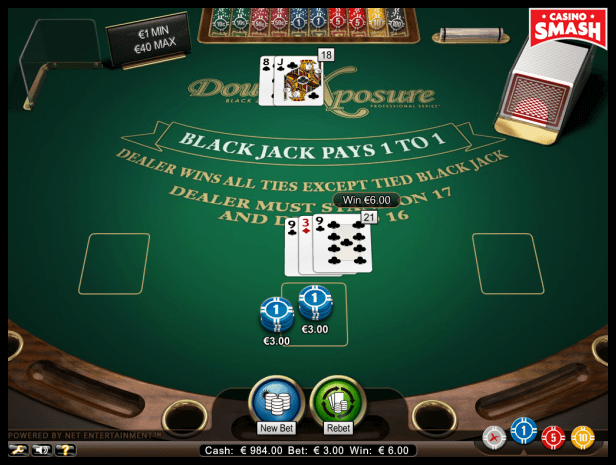
If you are new to playing blackjack, don’t be fooled by the fact that you can see both of the dealer’s cards in this game variant. Indeed, that gives you an edge, but in return, Face Up 21 is packed with many rules to compensate for the double exposure of the dealer’s hand. For example, you get an even money payout when you hit a natural 21, and you are restricted to doubling on cards from 9 to 11. Even more, the game has a higher house edge and lower RTP, which does not come as a surprise.
Certainly, we don’t intend to scare you by sharing these aspects of playing Face Up 21 Blackjack. Instead, this article aims to inform you about the game. In this article, you will learn about the gameplay, rules, the benefits that the game offers, and some valuable tips and strategies to help you beat the dealer.
What is Face Up 21 Blackjack, and how is it different from the others?
Face Up 21 or Double Exposure Blackjack is like every other game variant, focused between the dealer and the player, irrespective of the number of players involved. The game’s goal is simply to get blackjack as the winning hand or beat the dealer to the number 21 by having a hand value of 21 or being the closest. So, what makes Face 21 Blackjack different?
The significant difference that sets in motion many other talking points in the gameplay is how the cards are dealt. In different blackjack variants, the dealer either gets one card face up or none. However, in Face Up 21 Blackjack, the dealer receives two cards exposed to the player. That way, the player can have a clear picture and decide on the next move without second-guessing. You know your hand and what you need to win, making this game very simple and one of the most popular. Unfortunately, having both cards exposed also exposes the players to many dangers. So, it is crucial to learn the game rules and have multiple strategies to help you succeed.
How to play Face Up 21 Blackjack
If you have prior knowledge of playing blackjack, then you will find it easy, as always, to get started in a game of Face 21 Blackjack. However, if you plan to play for real money and succeed at the table, you must understand how to play this game.
Players are seated at the beginning of each round, bets are placed, and cards are dealt. The process is the same whether you play online in a live casino. Once the stakes are in, the dealer receives two cards open to every other player. Afterwards, based on your hand, you can make any of the following betting decisions:
- Hit: Immediately request another card if you feel your current hand is not good enough. Of course, seeing the dealer’s card value makes this decision very easy.
- Stand: When your current hand is a blackjack, 21, or strong enough based on your assessment, you can choose to stand. This means the game ends, and you win if your card value is stronger than the dealer’s. Of course, you must have seen the dealer’s hand before making this call, which also makes it an easy one.
- Double down: Imagine a scenario where the dealer’s hand is weak, and you have a very strong hand. Instead of standing, you can opt to double down, receive an additional card and stand afterwards.
- Split: When your first two cards are of the same value, you can choose to split them into separate hands. You must back the new hand with a new wager and play like two different hands. While this is easy, there are restrictions to the type of cards allowed for splitting in the Face Up 21 Blackjack game.
- Surrender: Sometimes, things might not go your way, and that’s part of the game. When your original hand is terrible, especially compared to the dealer, there is nothing you can do about it. Your best action at this point is to surrender. So, instead of losing your entire stake, you get half and live to fight another day.
Remember, the player makes the first call which could be any of these actions already described. Once that happens, the dealer plays his hand, and if it is blackjack or closest to 21, the dealer wins. The payout differs depending on the situation surrounding the win.
Face Up 21 Blackjack Card Value
Every card dealt has a value that could correspond to the face value. Usually, this is the same across the different variants of blackjack. So, knowing the value of your hand is crucial to the following action.
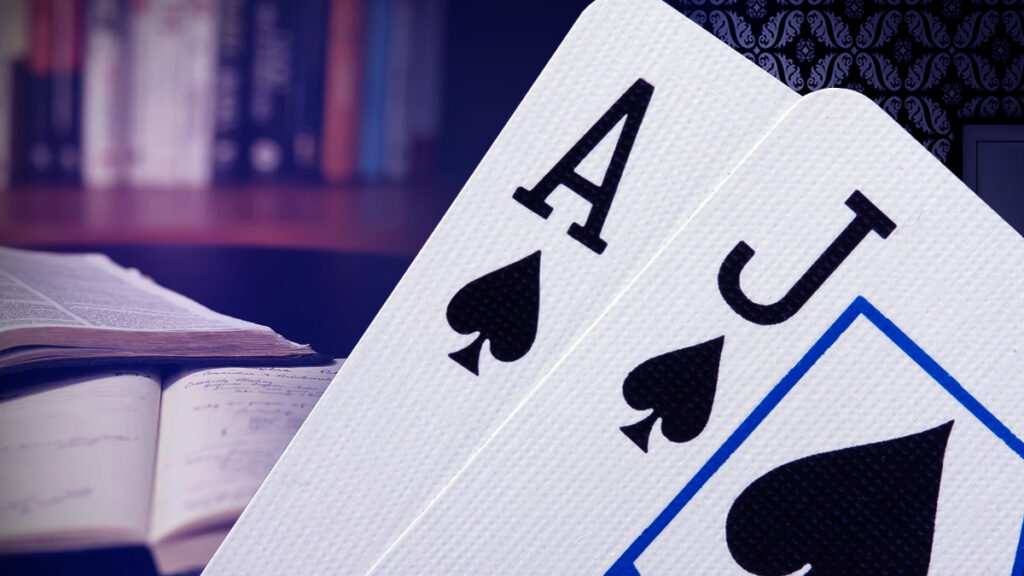
- Face value cards: 2, 3, 4, 5, 6, 7, 8, 9, and 10 are valued on the card.
- Aces: Valued as 1 or 11 depending on the situation in play (soft or hard hand).
- Court cards: Kings, Jacks, and Queens are worth 10.
For reference purposes, a hand is considered hard if it does not include an ace with a value of 11. Likewise, a soft hand contains an Ace valued at 11.
Depending on the value of your ace at a particular point in time, specific rules affect your gameplay and strategy, as will be discussed in the other sections.
Face Up 21 Blackjack Rules
Because this game looks so easy to play, considering that you get to see both of the dealer’s cards before making your next move, there are some strict rules that you must follow in the Face Up 21 Blackjack game. The game’s objective is always the same, but these rules limit how you go about it. Below are some of the most notable limitations of Face Up 21 Blackjack:
- The payout for Blackjack is 1 to 1 (even money) against 3 to 2 in most other game variations.
- When there is a tie, the dealer wins all hands except when the player has a blackjack.
- The player automatically wins a hand when the first two cards is a blackjack.
- Players can double down on hard totals of 9, 10 and 11
- Some casinos allow players to double down on an original hand.
- Splitting is allowed for all pairs. However, the player will only receive an additional card after splitting an ace.
- Splitting a face card, an ace, or a 10 does not count as a blackjack.
- The dealer stands on 17 or any higher card value.
- The dealer hits on cards up to 16
- The number of decks can vary depending on the casino or game provider.
- At the beginning of every game, the entire deck is shuffled.
Face Up 21 Blackjack House Edge and Payout System
The house edge for Face Up 21 Blackjack is higher than the traditional blackjack and many other variants, and that’s because of the dealer’s cards that are exposed. The impact of this on the house edge is as follows:
- Depending on the number of decks in use, the house edge varies. For example, it increases by 0.65 to 0.85% when 8 decks are used. This percentage can be more or less depending on the casino. The fewer decks in use results in lower the house edge.
- When players have more options to double; especially on a hand total of 9, 10, and 11 as against any two cards, the house edge increases by 0.25% up to 1.44% in some casinos.
- The house edge increases by 0.40% if the dealer opts to hit on a soft 17 instead of standing.
- The house edge increases by 0.71% on a single split of cards.
- If players are allowed to double down after splitting a hand, the house edge increases by 0.32%
- If the casino allows players to win a tied blackjack hand, the house edge increases by 0.22%
With all of these in place, the house edge increases with slight variations in the gameplay, which could be a massive disadvantage to players. These variations are not exact and vary from one casino to the other. Furthermore, there is a significant difference in the payout system between different blackjack variants. It is a 1:1 for all winning hands, including blackjack, compensating for the double exposure of the dealer’s card.
Face Up 21 Blackjack Strategies
It doesn’t matter the strategy you come across; the goal is the same, which is to minimize the house edge and turn the odds in your favour. As you surf the web, you will find so many strategies out there, each promising you victory over the dealer. Before we share some of the most popular strategies as it applies, particularly to Face Up 21 or Double Exposure Blackjack, it is crucial to state that these strategies will only guide you. It does not guarantee victory at the table. Below is a collection of popular tips you can try the next time you want to play Face Up 21 Blackjack.
- When your card value is between 17 and 21, the best logical thing to do is STAND. However, depending on the dealer’s card value, you can choose otherwise. Since both cards are exposed, you get to see them and decide on your next move. Remember, the dealer wins all ties except if the player has a blackjack. So, never STAND when you see that it is a tie.
- When the dealer has a 20, always HIT. Unless you have something better than a 20 (21 or a blackjack), you can only request another card and hope that the dealer does not STAND. You are busted and lose the entire bet for that round if he does.
- When your hand is an 11 or lower, you’ve got to HIT. That’s the only logical thing to do, as you are less likely to lose with the additional card but more certain to lose if you stand.
- If the dealer card is a 14 or higher (up to 16) and your hand is an 11 or lower, you have to DOUBLE DOWN. The dealer will likely HIT, and there’s a high chance of the dealer being busted with your additional card.
- Unless the dealer’s hand is an 11, 17, or higher, ALWAYS split your hand if it is an Ace. When this happens, there is a good chance of getting a second card with a high value of 10, and you could win both hands.
- NEVER SPLIT an Ace or any 10-value card unless the dealer’s hand is a hard 13 to 16. The chances of getting two winning hands from each are slim in such situations. Instead, getting a 20-value hand on a single bet is easier.
The charts below give an overview of some of the best betting decisions for Face Up 21 Blackjack, considering the dealer’s and players’ card values.
STRATEGY CHART
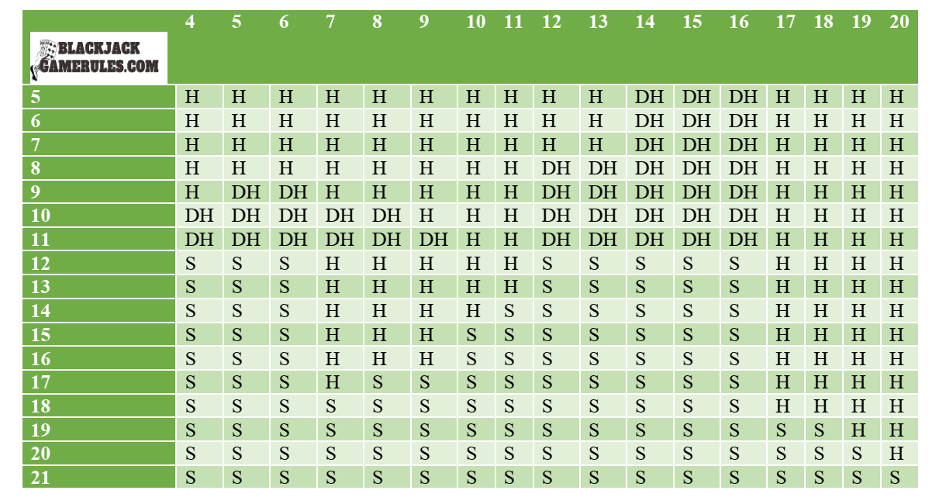
SOFT HAND (WITH AN ACE)
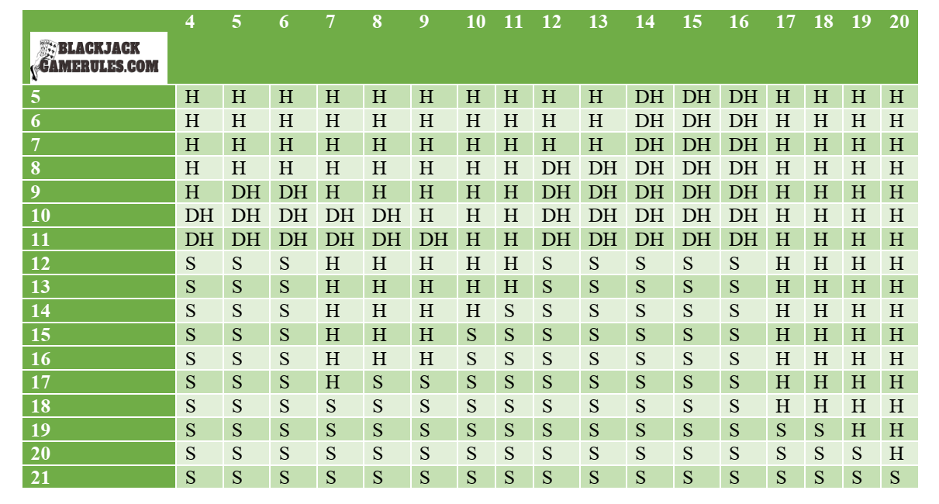
WHEN TO SPLIT
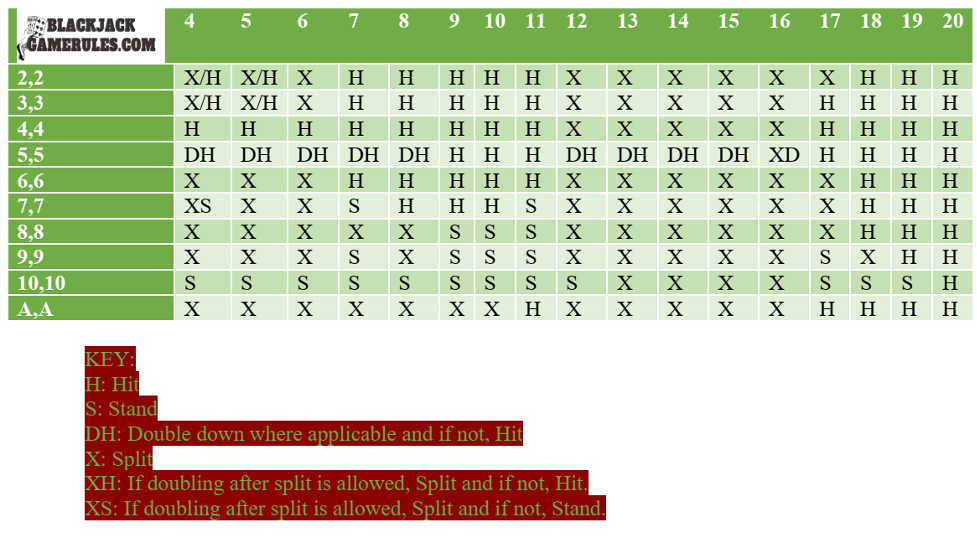
Ultimately, you won’t be allowed to enter a casino with a strategy chart. Of course, you can have it handy if you are playing in an online casino setting. However, it would be best if you study these charts, practice in the free-play mode, or use your bonuses to see what works best for you.
Conclusion
Face Up 21 or Double Exposure Blackjack is an exciting variant that allows players to enjoy a classic casino game. There are no side bets, and because the dealer’s cards are exposed, players cannot take insurance or surrender early in the game. The main feature that sets this variant aside is the exposure of the dealer’s card. This changes everything, including the house edge, payout percentage, rules, and strategies that apply to the game. It would be best if you got acquainted with the game rules each time you visit a casino, whether land-based or online.
FAQ
What is Face Up 21 Blackjack?
This is a blackjack game where the dealer receives two cards face up. In many other variants, one or none of the cards are exposed, but in this case, both are exposed, hence the name, double exposure blackjack in some casinos.
Is Face Up 21 Blackjack the same as Double Exposure Blackjack?
Yes, both are the same, although they are often used interchangeably depending on the casino. The game rules are the same, and the gameplay is hinged on the fact that both of the dealer’s cards are exposed.
Is Face Up 21 different from classical blackjack?
Yes, Face Up 21 Blackjack is slightly different in how the cards are dealt, the rules, the house edge and the payout. However, the game’s goal is the same as every other blackjack game: to hit a blackjack or beat the dealer to a 21 as much as possible.
What happens when there is a tie in Face Up 21 Blackjack?
The dealer wins every tie except if the player’s hand is a blackjack.
Can I use strategy charts and tips to play Face Up 21 Blackjack?
Yes, like every other blackjack variation, there are many tips and strategy charts to improve your odds of beating the dealer. However, be careful and ensure you test these tips when you have bonuses or try out some free games first.
